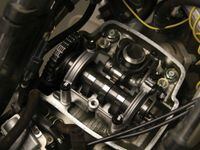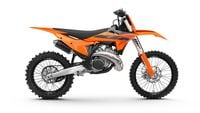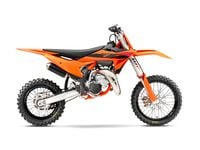It's a mystery to some and well understood by others. Inside that valve cover, above the cylinder head, spinning at half the speed of your crank is the cam (or cams). It's a shaft, usually riding on bearings, with a few funny-shaped bumps on it called lobes. These lobes, through a number of methods, control the opening and closing of the valves, and in doing so have a huge impact on your four-stroke's power and its engine's character.Dirt Rider set out to see how different cams affected power on a Honda CRF450X. We had bikes provided for us by Crowerpower, Web Cam and Hot Cams; we also brought along a stock bike to feel the difference a little lift or duration can make. We wanted to isolate the cam as much as possible but quickly found out how something that is proportionately inexpensive and nearly invisible-yet so crucial to the motorcycle-can get lost in the in-your-face simplicity of other easier, more common bolt-ons, such as pipe and jetting modifications. We rode the bikes with only the cam installed, as each bike was supposed to be delivered and jetted to run this way, using the stock pipe on all of them. Even though we explained our testing methods beforehand to the cam manufacturers, only one bike, the Crowerpower-equipped machine, actually ran acceptably with the stock pipe installed. The others were clearly not jetted with our methods in mind and hiccupped and sputtered until we spent considerable time rejetting them as best we could.For reference, we included the impression of the stock bike to use as a comparison to each of the modifications we tried, and included some other simple bolt-on products to show how their performances compared to the cams alone. Cams require a solid understanding of four-stroke mechanics to install as well as time (the 450X took about two hours, including readjusting the valves). Our experience is that quality aftermarket cams don't negatively affect durability under average conditions, but it should be noted that they are asking the valve train to do more than the stock cam does. We've included a complete CRF450X cam-install tech story on www.dirtrider.com to complement this story.Stock with Dr. D and White Brothers Pipes
The Dr. D system livened up the stock motor at the price of sound. Still below the 96-decibel level, the throttle response is perked up and the initial hit or jerk of the CRF is enhanced. Then the bike pulls with a little added steam everywhere.The White Brothers system gives the bike much more chug right off idle, also bumping up the sound levels, but still is responsible in output. From there, the torque feel of the motor is enhanced all the way to redline.Both these pipes are very similar in performance gains to a cam. They take about 10 minutes to mount but are a lot more expensive. Neither negatively affects engine life on the X.MT Vortex Ignition
www.mtracing.com; 951/353-1253 Price: $419
This plug-and-play modification replaces the stock CDI black box with a yellow one that contains 10 preprogramed ignition-timing curves, where you can select between two programs by flipping a handle-mounted switch. This mod is not only simple to install, it is actually fun to play with. Curves vary in character, from enhanced stock curves to stock with the rev-limiter raised to stock with the pink wire disconnected. There are CRF-R-type curves and some with different degrees of traction-enhancing tuning built in. Performance varies based on the curve, but the main curve, a boosted X curve, provides about the same amount of gain as a cam or a pipe. The traction maps all detuned the bike to varying degrees and really worked on low-traction situations.The ignition on the CRF-X took about 30 minutes to install and has been bulletproof in our experience, but since the rev-limiter is increased, riders who like to bounce the bike off of it or float valves could more easily damage their bike in the wrong curve.Jdjetting Kit
www.jdjetting.com; 253/939-7114 Price: $79.95
JDJetting provides a series of jets and detailed instructions on what jetting to use based on what modifications are done to your bike. We installed the jets and ran the stock pipe on our otherwise all-stock bike. It required that the airbox be opened up since the spec was definitely richer than standard. Once set up, the bike ran with a newfound low-low-end torque and produced better and smoother power all the way through the powerband. Power was increased everywhere, and jetting was spot-on, crisp and responsive the whole way through. (Note: This mod would not yield as much in gains to a bike that did not need the airbox opened up.)This mod gained a similar amount of performance compared to the cam and was moderately difficult to install; the process took about an hour, including cutting the airbox as recommended. The downsides were a slight decrease (average about 5-8 miles per tank) in fuel economy and the air filter getting dirty quicker. We've never seen any durability issues arise from a properly jetted bike.Conclusion
By comparison, a cam alone has similar gains (when jetted properly) to bolting on a pipe without any noticeable increase in noise. All of the cams liked to have the airbox opened up on the restrictive CRF450X, not surprising since their goal is to put more gas and air into the motor. The incremental change from stock to either a cam change or an exhaust with a jetting or ignition mod on the CRF450X is very similar; if you added just a pipe to one bike and just a cam to another they would perform similarly. Adding the second modification changes the power as well, but not as much as the first mod.Crowerpower G2 Cam
Price: $369 (no core)
Claimed lobe lift: 0.400 in.
Claimed Duration @ 0.050 in.: 254 intake and exhaustThe Crowerpower bike was the only test bike that ran properly with the stock exhaust, making it a clear winner for our intended test. Running this way, the cam gave the bike boosted torque right off of idle, which smoothed any hit that riders had complained of. It revved a little slower, dropped the happy place in the powerband lower in the rpm range and made good power all the way through. It really worked well for riders who are slower on the throttle.With the Dr. D pipe installed, the bike picked up some added oomph, which translated to a big increase in torque compared with the stock bike. Overall, the bottom and mid are boosted so much that the bike loses its appetite to rev-you just don't need to anymore. An added bonus was that the bike was less reluctant to break traction in higher-rpm running. Also, the pipe and cam combo increased the compression-braking effect, which some riders liked and others didn't. Most of our testers thought the big increase on the bottom and in torque would make this a favorite with trail riders.Web Cam
Price: $199 (no core)
Claimed lobe lift: -0.356 in. intake/-0.342 in. exhaust
Claimed duration @ 0.050 in.: -257 intake/258 exhaustCombined with the stock pipe, the Web Cam machine was smooth and torquey on the bottom with a lighter throttle feel (more revvy) and less hit than stock. Once more than half throttle, it started shooting ducks, bad. Opening up the airbox helped some, but it would take a different needle to make things right.Web Cam also opted to use the Dr. D pipe, which required we lean out the needle one clip position and open up the airbox. Then the bike still had the slight torque enhancement on bottom, where it came alive just earlier than stock with a very quick-revving nature, much more like an MX bike. In the mid, the bike really likes to rev but will still run a gear high easier than stock. The power builds very linearly throughout but now takes on more of a race nature. It's less chunky and more racy.Hot cams
Price: $189.95 (no core)
Claimed lobe lift: 0.377 in. intake/0.342 in. exhaust
Claimed duration @ 1mm: 237.5 intake/268.5 exhaustThe Hot Cams bike just would not run with the stock pipe. A bit of its refusal was traced back to the bleed jet in the carb. We put it back to stock at a #70 and this helped, but not enough. We could not get an impression of this cam using the stock pipe.Hot Cams teamed with White Brothers in the exhaust and made the power torquier than stock but not a lot faster in the lower-rpm range, where the power is softer compared with what then happens from the mid on up. The biggest gains were higher in the rpm range, where it pulled harder than stock. Not especially fast-revving, this setup was similar to stock in how far it revs out. Riding in the mid and top, you need good, smooth throttle control as the delivery gets more abrupt when you start pushing the bike. Again, our racier riders liked this setup, but trail hounds didn't.Cam Science
The basics
As complicated as modern four-strokes may be, it can be a help to anyone who works on his own motors to know more about how they operate. Dan Crower of Crowerpower cams showed us the ins and outs of cams.Cams control the opening and closing of the intake and exhaust valves and are as essential to four-stroke performance as cylinder porting is to a two-stroke. Basically, the cam is the brain of the motor controlling what are called the "events" in the valve train. By adjusting the timing of the events, such as deciding at what point in the cycle and how fast gasses can enter and exit the cylinder, it alters the motor's powerband.There are two basic elements involved in cam-valve events: lift and duration. "Lift" is how far the valve opens away from the head, and "duration" is how long the valve remains open. Obviously, more lift means more flow and longer duration means more time for gasses to flow through the valve ports. By altering the shape of the cam lobes, the part of the cam that actuates the valves, you change the lift and duration of the valves' opening.The exact science of designing the lobe shape involves using applied math and physics, but as Crower puts it, the key is to get as much air and gas into the cylinder as fast as possible: "Lift is your friend-it's good for power and it's good for flow-but you have to know how to close it or you will lose everything you've gained." Here is where duration comes into play. "Overlap" is the time that both intake and exhaust valves are open simultaneously, and a certain amount of overlap is critical in having the ideal duration. If you've waited for the exhaust to fully close before opening the intake, you are losing precious time, and the escaping exhaust may even help suck more intake charge into the cylinder at certain rpm. "Having too much overlap will make the motor soggy. Too much duration can help out a lot on the top-end, but it will kill torque. It requires finding a balance of the right kind of power," Crower explains. All of these factors are controlled by lobe shape, which is why each cam grind has a distinct power characteristic. Lobe shapes also vary drastically depending on how the cam activates the valve-through a rocker arm, on a tappet or over a bucket-and is influenced by the cam's position atop the cylinder head.Once the desired power delivery and lobe shape have been determined, Crower cuts an enlarged pattern of the lobe shape on a CNC mill called a cam profile. The profile is then put into the cam-shaping mill for manufacturing the new cams. The mill and profile are used like a giant key-cutting tool in which the profile is like your truck key that you want duplicated. On some cams, like the Honda CRF-X, a stock OEM cam is used as a core when cutting a Crower cam; the mill simply reshapes the lobes just like a key cutter would reshape a key blank.
Latest

/cloudfront-us-east-1.images.arcpublishing.com/octane/OBJOWDJVVRHAXHAPZEUU3LGMOU.jpg)
/cloudfront-us-east-1.images.arcpublishing.com/octane/JOBKLRXU75BKXMWSQZIVL4ODYA.jpg)
/cloudfront-us-east-1.images.arcpublishing.com/octane/SSQSO7OLVZGUZKZJR2BENIUBJQ.jpg)
/cloudfront-us-east-1.images.arcpublishing.com/octane/LFOPBF4YG5EGBGO4BOEETVPWG4.jpg)
/cloudfront-us-east-1.images.arcpublishing.com/octane/7OT73ORBCBEPPO6SX5JQ7P5O44.jpg)
/cloudfront-us-east-1.images.arcpublishing.com/octane/LGTWINGMIVGLJB35IXQJCSK67A.jpg)
/cloudfront-us-east-1.images.arcpublishing.com/octane/F7QWUM4NZFDQ5CXBP3H5BQ33YY.jpg)
/cloudfront-us-east-1.images.arcpublishing.com/octane/3GCSEHNJBFFRTEOEKRYN5ZMYJM.jpg)
/cloudfront-us-east-1.images.arcpublishing.com/octane/6JJ3XIOJWBED5DQIAKUBNCLTZE.jpg)
/cloudfront-us-east-1.images.arcpublishing.com/octane/EXJM3ZOP5JGOFL2BNU2G6KCGX4.jpg)
/cloudfront-us-east-1.images.arcpublishing.com/octane/2VHGWMYT4RE33JOHF3ATQ4CWBY.jpg)
/cloudfront-us-east-1.images.arcpublishing.com/octane/MAA7CTOAVJEH5H5QNC45LBIHPM.jpg)
/cloudfront-us-east-1.images.arcpublishing.com/octane/NOJSQ77E2BHR3IMKEJPCENML4A.jpg)
/cloudfront-us-east-1.images.arcpublishing.com/octane/B5QDMPSPWRA3RBBQJUC4FNI4JI.jpg)
/cloudfront-us-east-1.images.arcpublishing.com/octane/B3BPW2WOCNCUZPL2QVICQUC4VU.jpg)
/cloudfront-us-east-1.images.arcpublishing.com/octane/MLFO3UACYFHHLLP7WUYGUCFCBI.jpg)
/cloudfront-us-east-1.images.arcpublishing.com/octane/RS3JKVKIG5H2TFBCQXCLFWSJ6Q.jpg)
/cloudfront-us-east-1.images.arcpublishing.com/octane/6ONR4CR3FBB5PDN5SQPFB36CSI.jpg)
/cloudfront-us-east-1.images.arcpublishing.com/octane/3GF26TF5YVFIJCHZJMYTMWIPPY.jpg)
/cloudfront-us-east-1.images.arcpublishing.com/octane/QSWIPGJUFNAENBSGFG5ASKGUCY.jpg)
/cloudfront-us-east-1.images.arcpublishing.com/octane/JEB56YXHFZDYRBTQRSUPSIQT4E.jpg)
/cloudfront-us-east-1.images.arcpublishing.com/octane/2U42JYK7ZVCK5FISIIFYDLMFQY.jpg)

